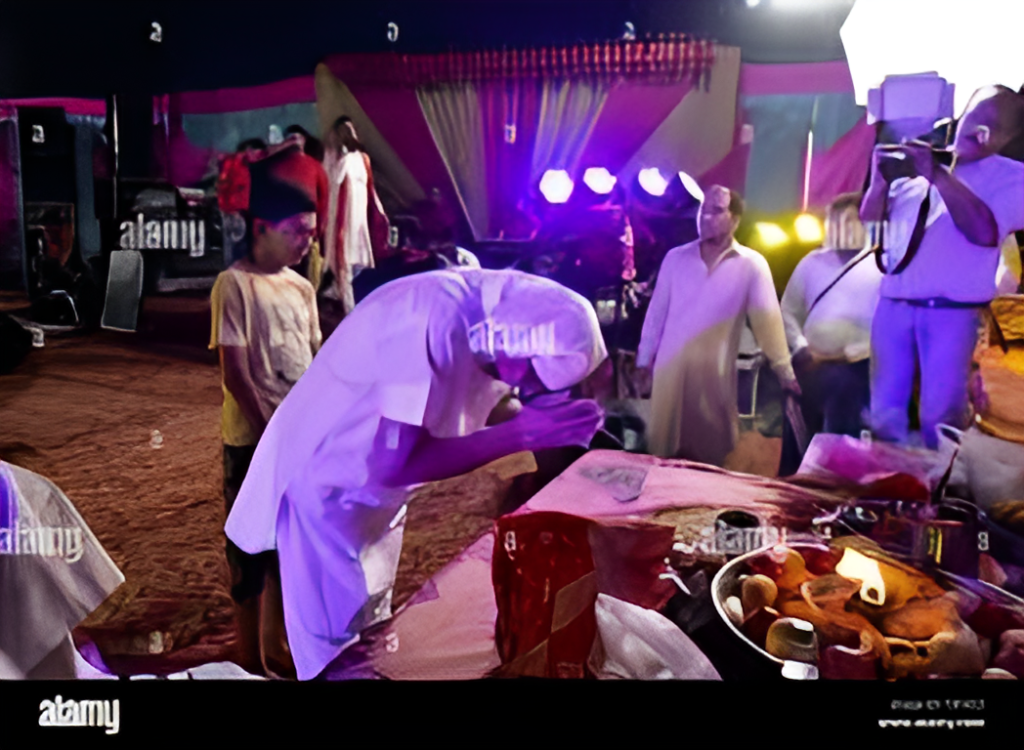Jagran rituals: A Jagran is a religious vigil or night-long devotional event observed by Hindus, primarily in honor of deities like Goddess Durga, Kali, or other manifestations of Shakti (divine feminine power). It is often held to seek blessings, express gratitude, or fulfill vows. The rituals of a Jagran rituals can vary depending on regional practices and the specific deity being worshiped, but here are the common elements:

1. Preparation for Jagran rituals
- Cleansing the Space: The space where the Jagran will take place, usually a temple or a designated area in the home, is cleaned and decorated.
- Altar Setup: An altar with idols or pictures of the deity (such as Durga or Kali) is set up, surrounded by flowers, lamps (diyas), incense, and other offerings.
- Devotional Items: Items like coconuts, fruits, sweets, and garlands are prepared to offer to the deity.
2. Invoking the Deity for Jagran rituals
- Kalas Sthapana: A ritual of placing a “kalash” (sacred pot) filled with water or grains is performed to invite the deity’s presence.
- Lighting of the Diya: A diya (lamp) is lit in front of the deity to signify the beginning of the Jagran, symbolizing divine light.
3. Bhajans and Kirtans
- Devotional Singing: Devotees sing bhajans (devotional songs) and kirtans (musical hymns) praising the deity. This is the heart of a Jagran, and it continues throughout the night.
- Participation of Musicians: Traditional instruments like dholaks, harmoniums, and cymbals are used to accompany the singing. Devotees often sing in turns, keeping the energy high.
4. Aarti (Worship with Light)
- Aarti Ceremony: Aarti is a significant Hindu ritual of worship that involves offering light to a deity in a spirit of devotion and gratitude. It is performed using a small flame or oil lamp, typically placed on a plate, which is rotated in front of a deity’s image or idol. This flame, representing light and energy, symbolizes the removal of darkness and ignorance, bringing divine blessings and positive energy into the space
- Offerings: Offerings like sweets, fruits, and flowers are made to the deity during aarti.
5. Chants and Recitations
- Mantras: The mantras or stotras (verses) related to the deity, such as the Durga Chalisa, are chanted to invoke blessings.
- Storytelling (Katha): In some Jagrans, a priest or a knowledgeable devotee narrates stories (kathas) from religious texts, such as episodes from the Ramayana, Mahabharata, or Puranas related to the deity.
6. Vrat (Fasting)
- Fasting: Many participants observe a fast during the Jagran, consuming only fruits or specific foods. This is considered a form of penance and devotion.
- Breaking the Fast: The fast is usually broken the next morning after the Jagran, with prasad (sacred food).
7. Processions and Dance
- Processions: In some communities, a procession with the deity’s idol or an image is taken around the area with devotional singing and dancing.
- Devotional Dance: Some devotees express their devotion through dance, particularly during moments of heightened devotion.
8. Closing the Jagran

- Final Aarti: As dawn approaches, a final aarti is performed to conclude the Jagran. It is a moment of offering gratitude and asking for the deity’s blessings.
- Prasad Distribution: After the final aarti, prasad is distributed to all the participants. This prasad typically consists of sweets, fruits, and other food items.
- Blessings and Farewell: The event often ends with the priest or organizer giving blessings, and the deity is symbolically sent off, closing the Jagran.
9. Social Aspect
- Community Participation: Jagrans are often community events, bringing together families and neighbors. There is a sense of camaraderie and collective devotion.
- Langar or Bhandara: In some cases, a community meal (bhandara or langar) is organized, where everyone eats together as a way of sharing divine blessings.

These are the core Jagran rituals that make up a typical Jagran. The event is a blend of spirituality, devotion, music, and community bonding, with a focus on staying awake and worshiping throughout the night.



Your means of telling all in this paragraph is truly good, every one be able to without
difficulty understand it, Thanks a lot. https://evolution.ORG.Ua/
Your means of telling all in this paragraph is truly good, every one be able to without difficulty understand it, Thanks a lot. https://evolution.ORG.Ua/